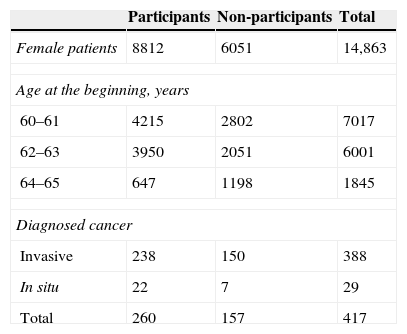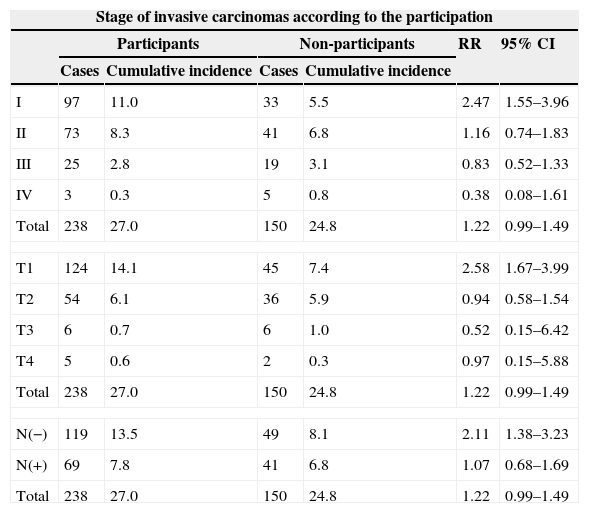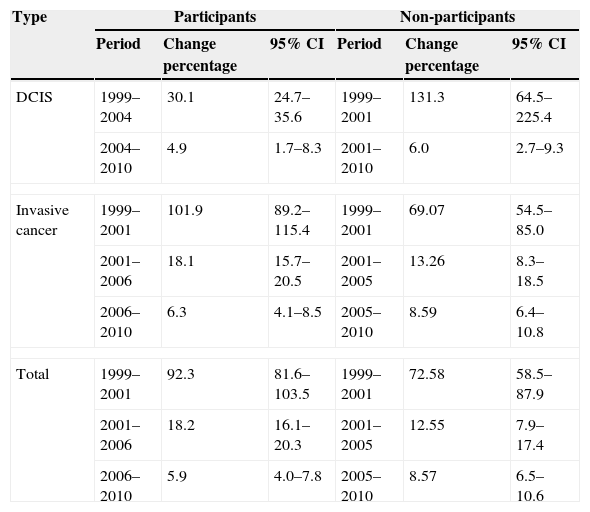To compare breast cancer cumulative incidence, time evolution and stage at diagnosis between participants and non-participant women in a population-based screening programme.
MethodsCohort study of breast cancer incidence in relation to participation in a population screening programme. The study population included women from the target population of the screening programme. The source of information for diagnostics and stages was the population-based cancer registry. The analysis period was 1999–2010.
ResultsThe relative risk for invasive, in situ, and total cancers diagnosed in participant women compared with non-participants were, respectively, 1.16 (0.94–1.43), 2.98 (1.16–7.62) and 1.22 (0.99–1.49). The relative risk for participants versus non-participants was 2.47 (1.55–3.96) for diagnosis at stage I, 2.58 (1.67–3.99) for T1 and 2.11 (1.38–3.23) for negative lymph node involvement. The cumulative incidence trend had two joint points in both arms, with an Annual Percent of Change of 92.3 (81.6–103.5) between 1999 and 2001, 18.2 (16.1–20.3) between 2001 and 2005 and 5.9 (4.0–7.8) for the last period in participants arm, and 72.6 (58.5–87.9) between 1999 and 2001, 12.6 (7.9–17.4) between 2001 and 2005, and 8.6 (6.5–10.6) in the last period in the non-participant arm.
ConclusionsParticipating in the breast cancer screening programme analysed increased the in situ cumulative cancer incidence, but not the invasive and total incidence. Diagnoses were earlier in the participant arm.
Comparar la incidencia acumulada de cáncer de mama, su evolución temporal y el estadio al diagnóstico entre mujeres participantes y no participantes en un programa poblacional de detección precoz.
MétodosEstudio de cohortes de incidencia de cáncer de mama en relación con la participación en un programa de cribado poblacional. La población de estudio fueron mujeres de la población diana del programa, y la fuente de información para los diagnósticos y estadios, el Registro poblacional de tumores. El período de análisis estuvo comprendido entre 1999 y 2010.
ResultadosLos riesgos relativos de diagnóstico de cáncer invasivo, in situ y total de las participantes en el programa respecto a las no participantes fueron, respectivamente, 1,16 (intervalo de confianza del 95% [IC 95%]: 0,94–1,43), 2,98 (IC 95%: 1,16–7,62) y 1,22 (IC 95%: 0,99–1,49). El riesgo relativo de participantes frente a no participantes para diagnóstico en estadioi fue de 2,47 (IC 95%: 1,55–3,96); para T1 de 2,58 (IC 95%: 1,67–3,99) y para afectación ganglionar negativa de 2,11 (IC 95%: 1,38–3,23). La incidencia acumulada tiene 2 puntos de cambio en ambos grupos, con unos porcentajes de cambio anual de 92,3 (IC 95%: 81,6–103,5) en 1999–2001, de 18,2 (IC 95%: 16,1–20,3) en 2001–2005 y de 5,9 (IC 95%: 4,0–7,8) en el último período en participantes, y de 72,6 (IC 95%: 58,5–87,9) para 1999–2001, de 12,6 (IC 95%: 7,9–17,4) en 2001–2005 y de 8,6 (IC 95%: 6,5–10,6) en el último período en no participantes.
ConclusionesLa participación en el programa de cribado de cáncer de mama analizado incrementa el riesgo de tener un diagnóstico de carcinoma in situ, mientras que no se incrementa el riesgo de cáncer invasivo. Por otra parte, los diagnósticos en este grupo se producen en estadios más precoces.











